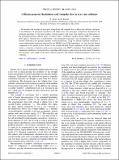Collision-geometry fluctuations and triangular flow in heavy-ion collisions
Author(s)
Alver, Burak Han; Roland, Gunther M
DownloadAlver-2010-Collision-geometry f.pdf (477.1Kb)
PUBLISHER_POLICY
Publisher Policy
Article is made available in accordance with the publisher's policy and may be subject to US copyright law. Please refer to the publisher's site for terms of use.
Terms of use
Metadata
Show full item recordAbstract
We introduce the concepts of participant triangularity and triangular flow in heavy-ion collisions, analogous to the definitions of participant eccentricity and elliptic flow. The participant triangularity characterizes the triangular anisotropy of the initial nuclear overlap geometry and arises from event-by-event fluctuations in the participant-nucleon collision points. In studies using a multiphase transport model (AMPT), a triangular flow signal is observed that is proportional to the participant triangularity and corresponds to a large third Fourier coefficient in two-particle azimuthal correlation functions. Using two-particle azimuthal correlations at large pseudorapidity separations measured by the PHOBOS and STAR experiments, we show that this Fourier component is also present in data. Ratios of the second and third Fourier coefficients in data exhibit similar trends as a function of centrality and transverse momentum as in AMPT calculations. These findings suggest a significant contribution of triangular flow to the ridge and broad away-side features observed in data. Triangular flow provides a new handle on the initial collision geometry and collective expansion dynamics in heavy-ion collisions.
Date issued
2010-05Department
Massachusetts Institute of Technology. Department of Physics; Massachusetts Institute of Technology. Laboratory for Nuclear ScienceJournal
Physical Review C
Publisher
American Physical Society
Citation
Alver, B., and G. Roland. “Collision-geometry fluctuations and triangular flow in heavy-ion collisions.” Physical Review C 81.5 (2010): 054905. © 2010 The American Physical Society.
Version: Final published version
ISSN
0556-2813